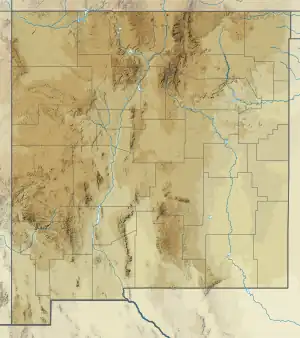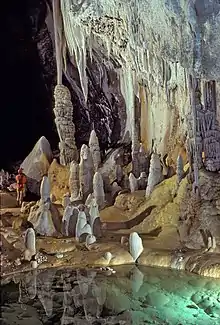| Lechuguilla Cave | |
|---|---|
 Largest known gypsum stalactites, Chandelier Ballroom (human at bottom gives scale) | |
  | |
| Location | Eddy County, New Mexico, U.S. |
| Nearest city | Carlsbad |
| Coordinates | 32°11′26″N 104°30′11″W / 32.19056°N 104.50306°W |
| Length | 138.3 mi (222.6 km) |
| Governing body | National Park Service |
At 150.4 miles (242.0 km), Lechuguilla Cave is the eighth-longest explored cave in the world[1] and the second deepest (1,604 feet or 489 meters) in the continental United States.[2] It is most famous for its unusual geology, rare formations, and pristine condition.
The cave is named for the canyon through which it is entered, which is named for Agave lechuguilla, a species of plant found there.[3] Lechuguilla is in Carlsbad Caverns National Park, New Mexico. Access to the cave is limited to approved scientific researchers, survey and exploration teams, and National Park Service management-related trips.
Exploration history
Lechuguilla Cave was known until 1986 as a small, insignificant historic site in the park's back country. Small amounts of bat guano were mined from the entrance passages for a year under a mining claim filed in 1914. The historic cave contained a 90-foot (27 m) entrance pit known as Misery Hole, which led to 400 feet (122 m) of dry, dead-end passages.[4]
The cave was visited infrequently after mining activities ceased. However, in the 1950s, cavers heard wind roaring up from the rubble-choked cave floor. Although no route was obvious, people concluded that cave passages lay below the rubble. Led by Dave Allured, a group of cavers from the Colorado Grotto gained permission from the National Park Service and began digging in 1984. Since the breakthrough into large walking passages occurred on May 26, 1986,[4] explorers have mapped over 138 miles (222 km) of passages,[1] making Lechuguilla the eighth-longest cave in the world and fourth-longest in the United States.[1] Lechuguilla was also the deepest known cave in the continental United States at 1,604 feet (489 m)[2] until the exploration of Tears of the Turtle Cave in 2014.[5] Drawn by the cave's pristine condition and rare beauty, cavers come from around the world to explore and map its passages and geology.[4]
In May 2012, a team led by Derek Bristol of Colorado climbed over 410 feet (120 m) into a dome and discovered several new, unexplored passages, pits, and large rooms. This new section was named "Oz", and many of its features were named after items from The Wizard of Oz. The discovery included a large room measuring 600 feet (180 m) long, up to 150 feet (46 m) wide, and up to 150 feet (46 m) high. It was named "Munchkinland". A pit, named "Kansas Twister", at over 510 feet (160 m) from floor to ceiling, is the deepest pit discovered in the park. The team spent eight days mapping Oz, adding the largest distance to the survey since 1989, and bringing the total length to 134.6 miles (216.6 km).[6]
Geology

Lechuguilla Cave offers more than extreme size. It holds a variety of rare speleothems, including lemon-yellow sulfur deposits, 20-foot (6.1 m) gypsum chandeliers, 20-foot (6.1 m) gypsum hairs and beards, 15-foot (4.6 m) soda straws, hydromagnesite balloons, cave pearls, subaqueous helictites, rusticles, U-loops, and J-loops. Lechuguilla Cave surpasses nearby Carlsbad Caverns in size, depth, and variety of speleothems, though no room has been discovered yet in Lechuguilla Cave that is larger than Carlsbad's Big Room.[4]
For the first time, a Guadalupe Mountains cave extends deep enough that scientists may study five separate geologic formations from the inside. The profusion of gypsum and sulfur lends support to speleogenesis by sulfuric acid dissolution. The sulfuric acid is believed to be derived from hydrogen sulfide that migrated from nearby oil deposits. Therefore, this cavern formed from the bottom up, in contrast to the normal top-down carbonic acid dissolution mechanism of cave formation.[4]
Lechuguilla Cave lies beneath a park wilderness area. The cave's passages may extend out of the park into adjacent Bureau of Land Management (BLM) land. A major threat to the cave is proposed gas and oil drilling on BLM land.[7] Any leakage of gas or fluids into the cave's passages could kill cave life or cause explosions.[4]
Microbiology
Rare chemolithoautotrophic bacteria are believed to occur in the cave. These bacteria feed on the sulfur, iron, and manganese minerals and may assist in enlarging the cave and determining the shapes of unusual speleothems. The claim in the BBC documentary series Planet Earth that these bacteria do not derive any energy from the sun is incorrect, in that sulfur-oxidizing bacteria found in the cave use atmospheric oxygen (derived from sunlight-driven photosynthesis) as an electron acceptor, with the electron donor (source of energy) derived from dissolved groundwater hydrogen sulfide gas.[8][9]
Other studies indicate that some microbes may have medicinal qualities that are beneficial to humans.[4] Some of the bacterial strains isolated from the cave have been found to harbor novel pathways for antibiotic resistance.[10][11] A 4 million year-old strain of Paenibacillus isolated from soil samples in Lechuguilla Cave was found to be naturally resistant to many modern antibiotics, including daptomycin.[11]
Filming
The Denver Museum of Nature and Science filmed one of the first documentaries in the cave, titled Lechuguilla Cave: The Hidden Giant, in 1987, featuring many of the cavers responsible for the breakthrough and initial survey work. The video was broadcast on the Denver PBS station KRMA-TV in 1989.
The 1992 National Geographic Society program titled Mysteries Underground was also filmed extensively in Lechuguilla Cave.[12]
Lechuguilla Cave was also shown in the BBC documentary series Planet Earth. The fourth episode, titled "Caves", airing on April 22, 2007, documented scientists and filmmakers exploring Lechuguilla Cave, including the Chandelier Ballroom, which has high-quality crystals. The team took two years to get permission to film.[13]
In October 2016, crew members from London-based production company Nutopia[14] descended into Lechuguilla Cave with microbiologist Hazel Barton[15] to film a sequence for season 1, episode 4 (titled "Genesis") of the National Geographic series One Strange Rock.[16]
See also
References
- 1 2 3 Bob Gulden (June 20, 2013). "Worlds longest caves". Geo2 Committee on Long and Deep Caves. National Speleological Society (NSS). Retrieved June 23, 2013.
- 1 2 Bob Gulden (June 20, 2013). "USA deepest caves". Geo2 Committee on Long and Deep Caves. NSS. Retrieved June 23, 2013.
- ↑ Cahill, Tim (1994). "Lechuguilla". Pecked to Death by Ducks. New York: Random House.
- 1 2 3 4 5 6 7 "Carlsbad Caverns National Park: Lechuguilla Cave". NPS. Retrieved January 22, 2009.
- ↑ Gulden, Bob (December 4, 2020). "USA deepest caves". caverbob.com.
- ↑ "Deepest pit found in Lechuguilla Cave". Current-Argus. Archived from the original on November 24, 2012. Retrieved June 18, 2012.
- ↑ "Oil drilling on sensitive New Mexico public lands puts drinking water, rare caves at risk". Environment. February 3, 2021. Archived from the original on February 3, 2021. Retrieved February 5, 2021.
- ↑ Diana E. Northup, Kathleen Lavoie (2001): Geomicrobiology of Caves: A Review, Geomicrobiology Journal, 18:3, 199–222
- ↑ Bacteria, fungi and biokarst in Lechuguilla Cave, Carlsbad Caverns National Park, New Mexico K. I. Cunningham, D. E. Northup, R. M. Pollastro, W. G. Wright and E. J. LaRock, Environmental Geology Volume 25, Number 1, 2–8, doi:10.1007/BF01061824
- ↑ Bhullar, Kirandeep; et al. (2012). "Antibiotic Resistance Is Prevalent in an Isolated Cave Microbiome". PLOS One. 7 (4): e34953. Bibcode:2012PLoSO...734953B. doi:10.1371/journal.pone.0034953. PMC 3324550. PMID 22509370.
- 1 2 Pawlowski, Andrew C.; et al. (2016). "A diverse intrinsic antibiotic resistome from a cave bacterium". Nature Communications. 7: 13803. Bibcode:2016NatCo...713803P. doi:10.1038/ncomms13803. PMC 5155152. PMID 27929110.
- ↑ Mysteries Underground (1992)
- ↑ "Caves". Planet Earth. Season 1. Episode 4. April 22, 2007.
- ↑ "One Strange Rock". Nutopia.
- ↑ "'One Strange Rock': UA biologist featured in National Geographic documentary". The University of Akron University Communications and Marketing. The University of Akron. April 16, 2018.
- ↑ "One Strange Rock". National Geographic. National Geographic. Archived from the original on July 1, 2018. Retrieved April 18, 2018.
- Mysteries Underground in libraries (WorldCat catalog)